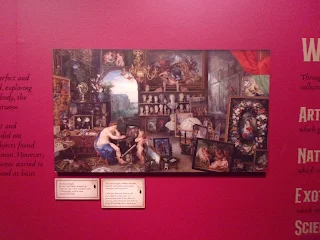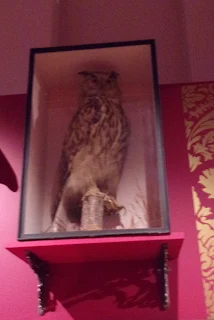Wunderkammer (German- "wonder chamber")
In this instance a cabinet doesn't actually mean a piece of furniture. It means a room, and a wunderkammer is a cabinet of curiosities, originally used to display rare natural history objects. They were the predecessors to museums, date back to the 16th century but reached their apex during the Victorian era.
I have also created a YouTube vlog, link:-
We visited this single room of displays within Southend Central Museum on a very warm day last year, when we were in Southend for a couple of nights to celebrate my birthday.
This is from a set of paintings about the five senses.
This instrument is called an Ophicleide, and is a predecessor to the tuba.
Some form of dead animal- it looks decidedly feline...
Mr Owl keeping watch all over all of us, probably wondering what kind of weirdo would find all of this strange stuff fascinating!
It was the fan which caught my eye the most in this varied cabinet.
This was in a separate little makeshift room, and depicts another cabinet of curiosities...
A naked man and what appears to be a turtle or tortoise shell hanging on the wall, although closer inspection reveals uniform lines so I'm flummoxed...
I loved the mother of pearl visiting card case- so elegant.
Beautiful vases with an oriental appeal...
If my memory serves me correctly (and that's the trouble with blogging six months after you actually visited something) you could stand directly underneath this very Victorian lampshade and listen to a commentary about collector Charles Nicholson, who was born locally in Hadleigh.
Swimming with the fishes...
View over the vibrant room and the chairs were certainly in keeping with the (strangely oppressive, although maybe that's intentional?) décor..
Statuesque gramophone...
Varied cabinet with what appears to be eggs and seahorse skeletons inside, amongst other things.
The outside of this atmospheric little room...
It was my favourite piece, and is a reminder that Wunderkammers were used to display wealth and power- only the richest, most erudite and powerful could amass large collections of artefacts.
The whole exhibition acknowledges how some things are really not ours for the taking, and it does fill you with a sense of unease as you look around...
A taxidermy deer with hanging butterflies...
The butterflies are exhibited hanging onto Perspex tubes. It's an effect that's both pretty, but undeniably disturbing. I think that's the point of Wunderkammers nowadays- to arouse, excite and make you contemplate...
Buttons and buckles- a variation on the button tins of yesteryear which our mums and nans kept...
Jars, ore deposits and shells, and something very interesting in the central right hand section...
This is a Neo-Assyrian (911-612 BC) stone toy chariot. Southend Museum's documentation states that the charioteer is in the British Museum...
Mummies, a Vain Old Tart and another very interesting object which piqued my interest...
Mummia and Mummy cloth. Mummia was used liberally on wounds and rashes, and was the most common substance found in apothecaries in the 16th century. Mummia was made by grinding up Ancient Egyptian mummies, and dates back to the early 1100s. Here we can see a vial, and the cloth most likely belonged to the mummy residing in the vial.
More mini-mummies and jewellery, plus a Vain Old Tart again.
The exhibition shows clear links between colonialism and exploiting other, indigenous cultures; by amassing artefacts obtained by unequal gifting or force.
Southend Central Museum also houses its regular historical exhibition, but as we were pushed for time and had somewhere to be I only honed in on a few objects on display here.
This is a one-person air raid shelter from the Second World War.
This is a two-tonne cannon from the shipwreck of The London; a 17th century Cromwellian warship which mysteriously exploded in the Thames Estuary in 1665.
This is a cabinet full of Bakelite objects. In the early noughties I visited the Bakelite Museum in Williton, Somerset, which was crammed to the rafters with a plethora of artefacts, but I believe it's now closed for good.
We'll end this blog with a photo of my little owl, Ollie, who sits on my desk keeping my stationery holder warm. I bought him from the museum some years back.
💓
If you want to look at a really freaky collection of (some might say distasteful) thingumajigs, then you might want to check out this Viktor Wynd Museum in Hackney, London.
Here is the link:-
Southend Central Museum, I will return- it's always nice to spend half and hour to an hour here.
Until then.
TTFN
The Miss Elaineous
XXXXXXXXX
XXXXX
X


























.JPG)







No comments:
Post a Comment